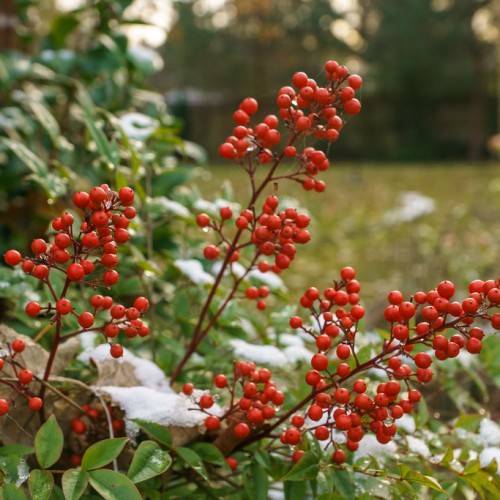
nandina
Nandina domestica
Cycle:
Perennial
Watering:
Average
Hardiness Zone:
6 - 9
Flowers:
Flowers In Summer
Sun:
Part sun/part shade, Sheltered
Fruits:
Fruits In Autumn Ready In Fall
Leaf:
Yes
Growth Rate:
Moderate
Maintenance:
Moderate
Invasive:
Yes
Care Level:
Medium
watering
Nandina domestica should be watered weekly during the growing season. When it is first planted, it should be watered more frequently but then space out the watering as the plant gets settled. During the warmer months, water the soil deeply enough that it penetrates 8-10 inches below the soil's surface. In cooler climates, water every 10-14 days. After the first few weeks, reduce watering to once or twice every 2 weeks. In the winter, Nandina domestica needs much less water. It should only be watered once a month, as overwatering can lead to root rot.
sunlight
Nandina domestica prefers direct sunlight for at least 4 hours a day, preferably in the morning or early afternoon. However, Nandina domestica can tolerate partial shade, especially in warmer climates. It is important to ensure that the plant is not exposed to bright sun for an extended period of time as this can cause the foliage to burn. If in direct sunlight, it is best to provide some afternoon shade to prevent sunburn. Nandina domestica can also benefit from some night-time darkness for several weeks in the winter months.
pruning
Nandina domestica is a species of evergreen shrub that grows well in indirect sunlight or partial shade and needs very little pruning. It tends to grow in an upright and rounded shape and can reach heights of up to 6 feet. However, pruning is necessary to keep the plants shape and a healthy growth rate. Pruning should typically be done in late winter or early spring to encourage healthy new growth. During the pruning process, hand pruners should be used to remove any dead or damaged branches. The shrubs can be pruned by 1-third or even halved to maintain their natural shape. It should be noted that pruning Nandina domestica too drastically can cause it to become leggy and stop flowering. All in all, the amount of pruning required for Nandina domestica is minimal compared to other shrubs. Pruning should be done in late winter or early spring with hand pruners and it is important not to prune too drastically as this can cause the plant to become leggy.
